Mises, Ludwig von. Human Action: A Treatise on Economics
Подождите немного. Документ загружается.

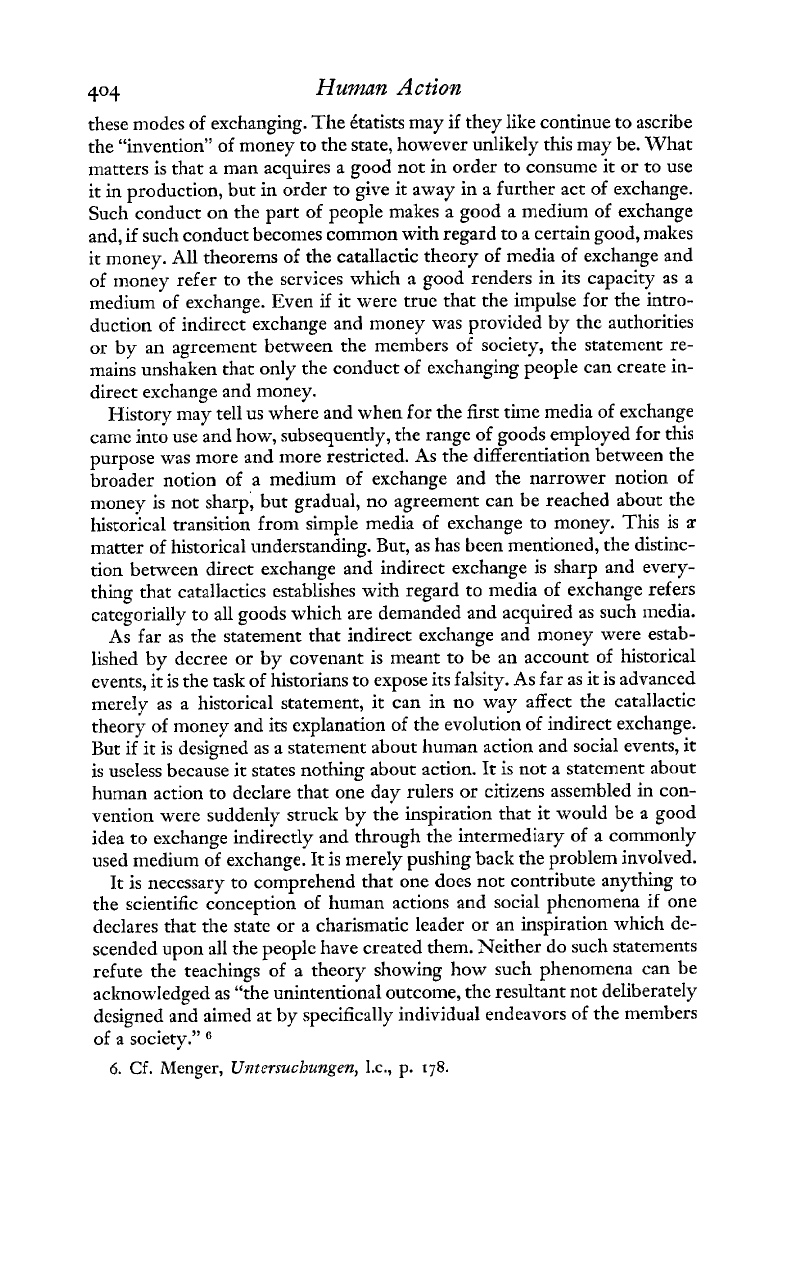
404
Hunzan
Action
these modes of exchanging. The ktatists may if they like continue to ascribe
the "invention" of money to the state, however unlikely this may be. What
matters is that a man acquires a good not
in
order to consume it or to use
it in production, but in order to give it away in a further act of exchange.
Such conduct on the part of people makes a good a medium of exchange
and, if such conduct beconles common with regard to a certain good, makes
it money. All theorems of the catallactic theory of media of exchange and
of money refer to the services which a good renders in its capacity as a
medium of exchange. Even
if
it were true that the impulse for the intro-
duction of indirect exchange and money was provided by the authorities
or
by
an agreement between the members of society, the statement re-
mains unshaken that only the conduct of exchanging people can create in-
direct exchange and money.
History may tell us where and when for the first time media of exchange
came into use and how, subsequently, the range of goods employed for this
purpose was more and more restricted. As the differentiation between the
broader notion of a medium of exchange and the narrower notion of
money is not sharp, but gradual, no agreement can be reached about the
historical transition from simple media of exchange to money. This is
a
matter of historical understanding. But, as has been mentioned, the distinc-
tion between direct exchange and indirect exchange is sharp and every-
thing that catallactics establishes with regard to media of exchange refers
categorially to all goods which are demanded and acquired as such media.
As far as the statement that indirect exchange and money were estab-
lished by decree or by covenant is meant to be an account of historical
events, it is the task of historians to expose its falsity. As far as it is advanced
merely as a historical statement, it can in no way affect the catallactic
theory of money and its explanation of the evolution of indirect exchange.
But if it is designed as a statement about human action and social events, it
is useless because it states nothing about action. It
is
not a statement about
human action to declare that one day rulers or citizens assembled in con-
vention were suddenly struck by the inspiration that it would be a good
idea to exchange indirectly and through the intermediary of a commonly
used ~nedium of exchange. It is merely pushing back the problem involved.
It is necessary to comprehend that one does not contribute anything to
the scientific conception of human actions and social phenomena if one
declares that the state or a charismatic leader or an inspiration which de-
scended upon all the people have created them. Neither do such statements
refute the teachings of a theory showing how such phenomena can be
aclrnowledged as "the unintentional outcome, the resultant not deliberately
designed and aimed at by specifically individual endeavors of the members
of a society."
6.
Cf.
hknger,
Untersuchungen,
LC.,
p.
178.
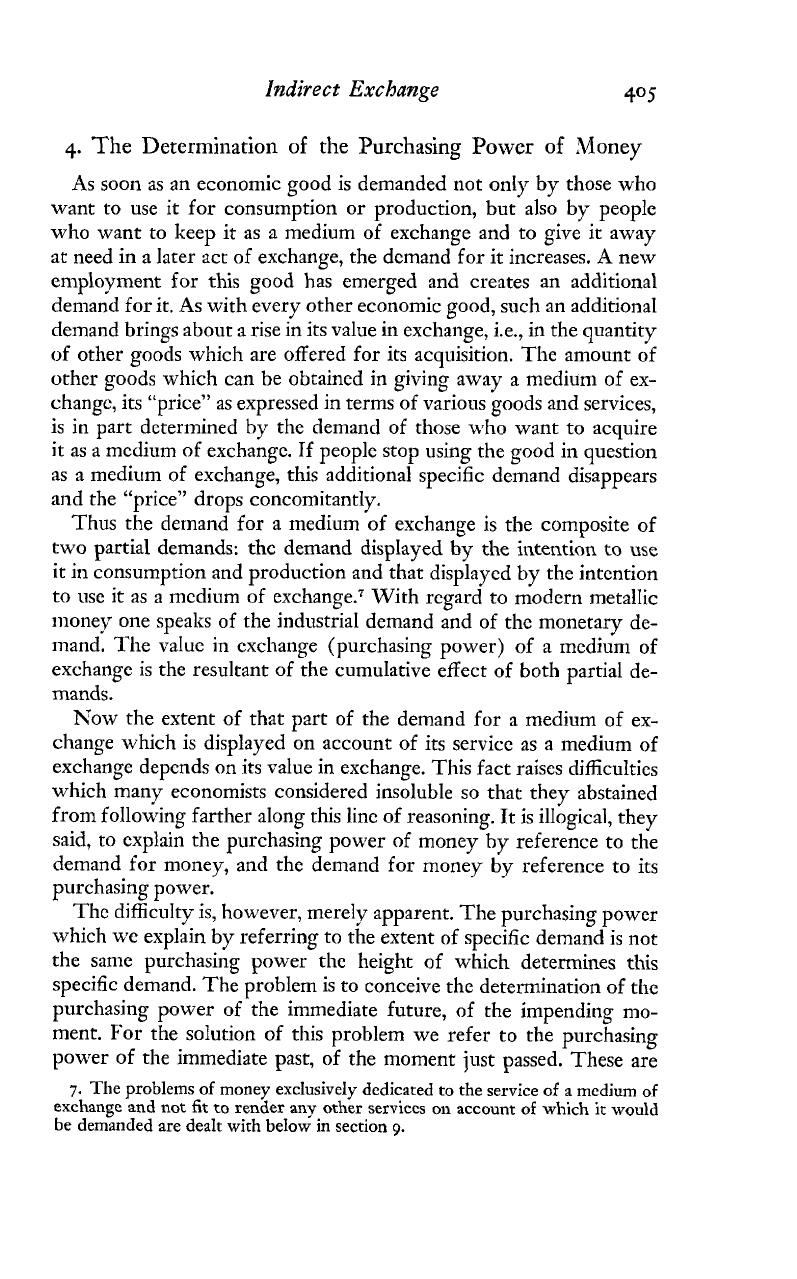
Indirect
Exchange
405
4.
The Determination
of
the
Purchasing
Powcr
of Money
As soon as an economic good is demanded not only by those who
want to use it for consumption or production, but also by people
who want to keep it as a medium of exchange and to give it away
at need in a later act of exchange, the demand for it increases. A new
employment for this good has emerged and creates an additional
demand for it. As with every other economic good, such an additional
demand brings about a rise in its value in exchange, i.e., in the quantity
of other goods which are offered for its acquisition. The amount of
other goods which can be obtained in giving away a medium of ex-
change, its "price" as expressed in terms of various goods and services,
is in part determined
by
the demand of those who want to acquire
it as a medium of exchange. If people stop using the good in question
as a medium of exchange, this additional specific demand disappears
and the "price" drops concomitantly.
Thus the dernand for a medium of exchange is the composite of
two partial demands: the demand displayed
by
the intention
to
use
it in consumption and production and that displayed by the intention
to use it as a medium of ~xchange.~ With regard to modern metalIic
money one speaks of the industrial demand and of the monetary de-
mand. The vaIue
in
exchange (purchasing power) of a medium of
exchange is the resultant of the cumulative effect of both partial de-
mands.
Now the extent of that part of the demand for a medium of ex-
change which is displayed on account of its service as a medium of
exchange depends on its value in exchange. This fact raises difficulties
which many economists considered insoluble so that they abstained
from following farther along this line of reasoning. It is illogical, they
said, to explain the purchasing pourer of money
by
reference to the
demand for money, and the demand for money by reference to its
purchasing power.
The difficulty is, however, merely apparent. The purchasing power
which we explain by referring to the extent of specific demand is not
the same purchasing power the height of which determines this
specific demand. The problem is to conceive the determination of the
purchasing power of the immediate future, of the impending mo-
ment. For the solution of this problem we refer to the purchasing
pourer of the immediate past, of the moment just passed. These are
7.
The problems
of
money exclusively dedicated to the service
of
a medium
of
exchange
and
not fit
to
render any other services
on
account of which
it
would
be demanded are dealt with beIow in section
9.
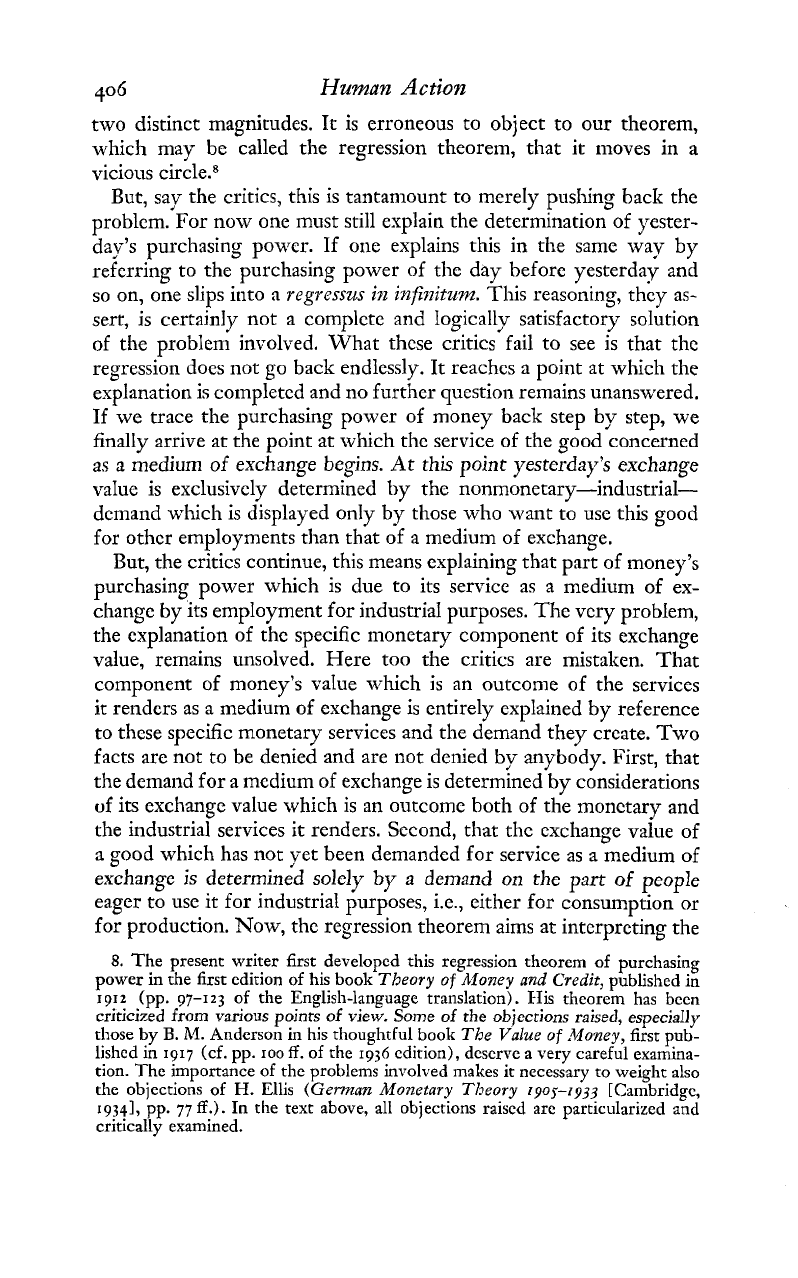
406
Human
Action
two distinct magnitudes. It is erroneous to object to our theorem,
which may be called the regression theorem, that it moves in
a
vicious circle.*
But, say the critics, this is tantamount to merely pushing back the
problem. For now one must still explain the determination of yester-
day's purchasing power. If one explains this in the same way by
referring to the purchasing power of the day before yesterday and
so on, one slips into a
regmsus
in
infinitzdnz.
This reasoning, they as-
sert, is certainly not a complete and logically satisfactory solution
of the problem involved. What these critics fail to see is that the
regression does not go back endlessly. It reaches a point at which the
explanation is completed and no further question remains unanswered.
If
we
trace the purchasing power of money back step by step, we
finally arrive at the point at which the service of the good concerned
as
a medium of exchange begins.
At this point yesterday's
exchange
vaIuc is exclusively determined by the nonmonetary-industrial-
demand which is displayed only by those who want to use this good
for other employments than that df a medium of exchange.
But, the critics continue, this means explaining that part of money's
purchasing power which is due to its service as a medium of ex-
change by its employment for industria1 purposes. The very probIem,
the explanation of the specific monetary component of its exchange
value, remains unsolved. Here too the critics are mistaken. That
component of money's vaIue which is an outcome of the services
it renders as a medium of exchange is entirely explained by reference
to these specific monetary services and the demand they create. Two
facts are not to be denied and are not denied by anybody. First, that
the demand for a medium of exchange is determined by considerations
of its exchange value which is an outcome both of the monetary and
the industrial services it renders. Second, that thc exchange value of
3
good which has not yet been demanded for service as a medium of
exchange is determined
solely by a
demand
on
the
part
of
people
eager to use it for industrial purposes, ix., either for consumption or
for production. Now, the regression theorem aims
at
interpreting the
8.
The present writer first developed this regression theorem of purchasing
power in the first edition of his book
Theory of Money and Credit,
published in
1912
(pp.
97-123
of the English-language translation). His theorem has been
criticized from various points of view. Some of the objections raised, especially
those
by
B.
Ail.
Anderson in his thoughtful book
The Value of Noney,
first pub-
lished
in
1917
(cf. pp.
loo
ff.
of the
1936
edition), dcscrve a very careful examina-
tion. The importance of the problems involved makes it necessary to weight also
the objections of
H.
Ellis
(German Monetary TI~eory
ZYOJ-~Y~~
[Cambridge,
19341, pp.
77
ff.).
In
the text above, all objections raised are particularized and
critically examined.
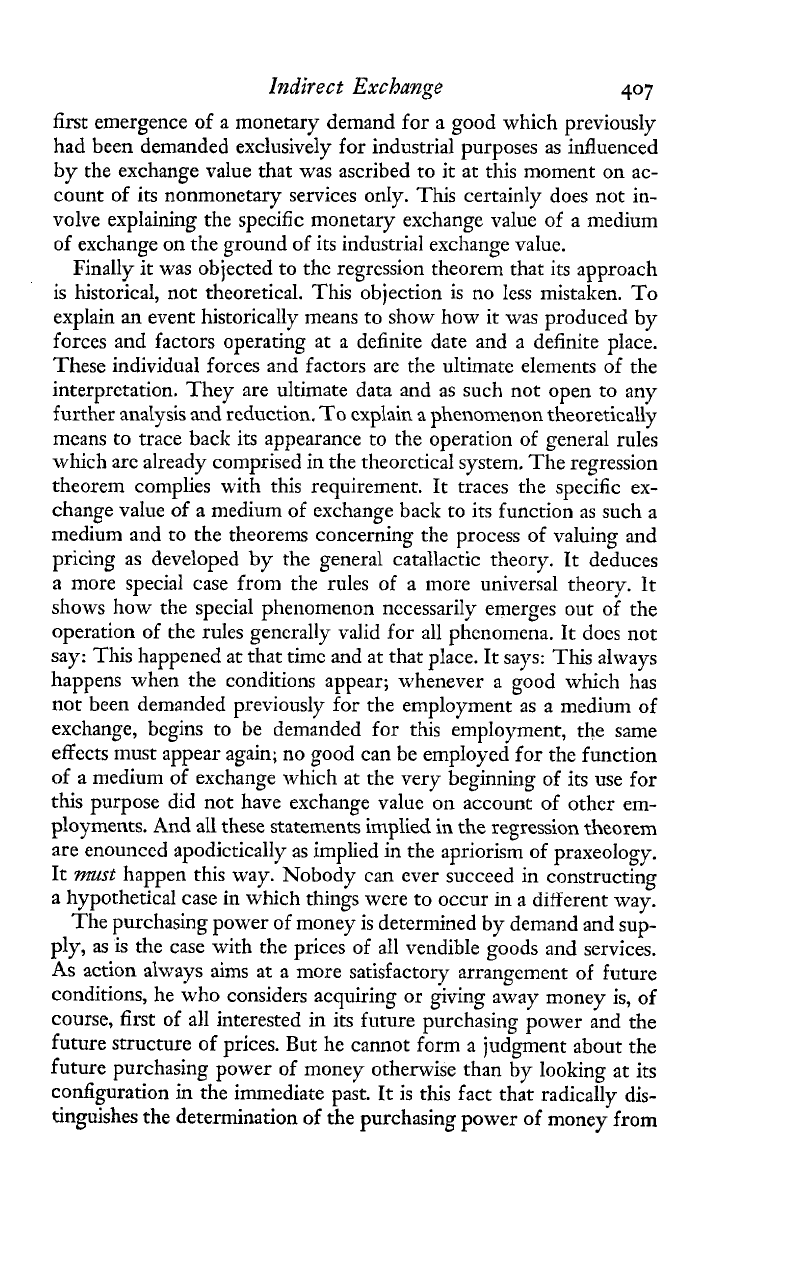
Indirect
Exchange
407
first emergence of a monetary demand for a good which previously
had been demanded exclusively for industrial purposes as influenced
by the exchange value that was ascribed to it at this moment on ac-
count of its nonmonetary services only. This certainly does not in-
volve explaining the specific monetary exchange value of a medium
of exchange on the ground of its industrial exchange value.
Finally it was objected to the regression theorem that its approach
is historical, not theoretical. This objection is no less mistaken. To
explain
an
event historically means to show how it was produced by
forces and factors operating at a definite date and a definite place.
These individual forces and factors are the ultimate elements of the
interpretation. They are ultimate data and as such not open to any
further
analysis and
reduction.
To
explain
a
phenomenon theoretica11y
means
to
trace back its appearance to the operation of general rules
which are already comprised in the theoretical system. The regression
theorem complies with this requirement. It traces the specific ex-
change value of a medium of exchange back to its function as such a
medium and to the theorems concerning the process of valuing and
pricing as developed by the general catallactic theory.
It
deduces
a
more special case from the rules of a more universal theory. It
shows how the special phenomenon necessarily emerges out of the
operation of the rules
generally
valid for all phenomena. It docs not
say: This happened at that timc and at that place. It says: This always
happens when the conditions appear; whenever a good which has
not been demanded previously for the employment as a medium of
exchange, begins to be demanded for this employment, the same
effects must appear again; no good can be employed for the function
of a medium of exchange which at the very beginning of its use for
this purpose did not have exchange value on account of other em-
ployments. And all these statements implied in the regression theorem
are enounced apodictically as implied in the apriorism of praxeology.
It
mst
happen this way. Nobody can ever succeed in constructing
a hypothetical case in which things were to occur in a different way.
The purchasing power of money is determined by demand and sup-
ply, as is the case with the prices of a11 vendible goods and services.
As action always aims at a more satisfactory arrangement of future
conditions, he who considers acquiring or giving away money is, of
course, first of all interested in its future purchasing power and the
future structure of prices. But he cannot form a judgment about the
future purchasing power of money otherwise than by looking at its
configuration in the immediate past. It is this fact that radically dis-
tinguishes the determination of the purchasing power of money from
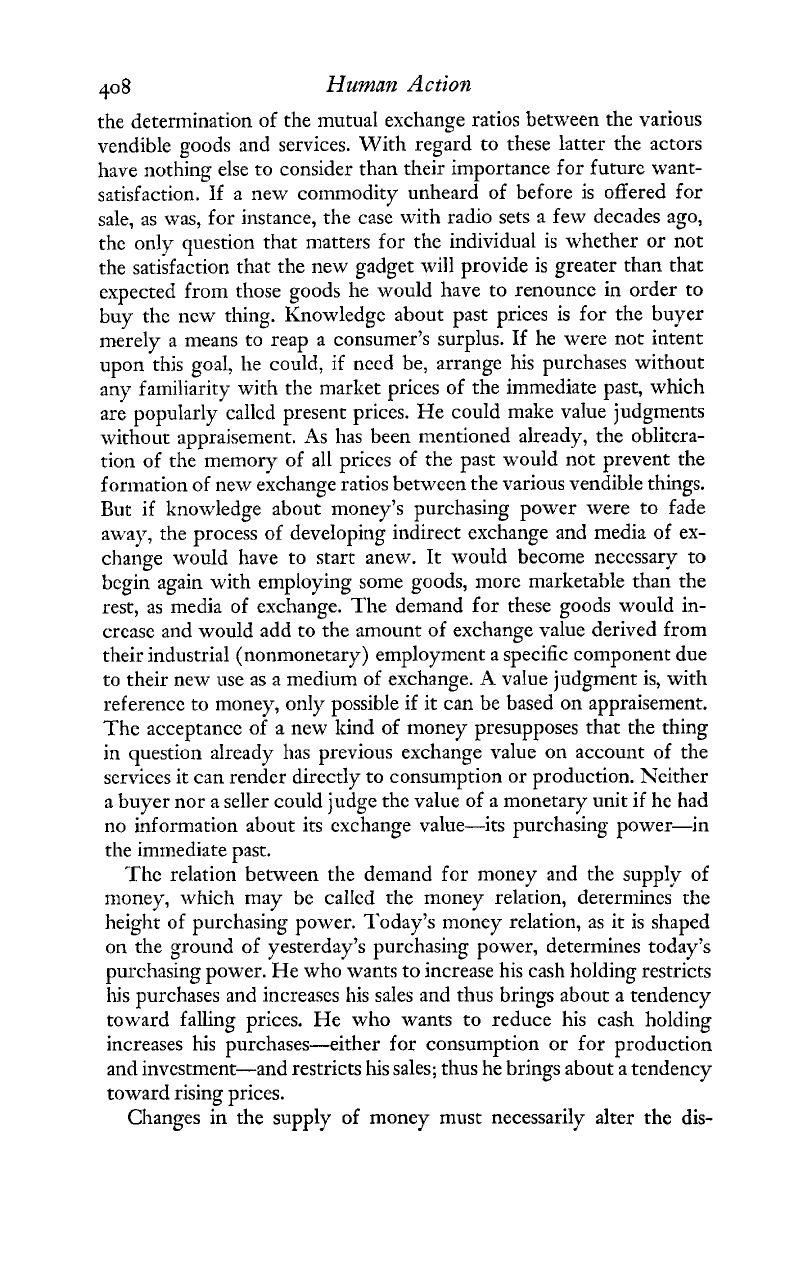
408
Human
Action
the determination of the mutual exchange ratios between the various
vendible goods and services.
With
regard to these latter the actors
have nothing else to consider than their importance for future tvant-
satisfaction. If a new commodity unheard of before is offered for
sale, as was, for instance, the case with radio sets a few decades ago,
the
only
question that matters for the individual is whether or not
the satisfaction that the new gadget will provide is greater than that
expected from those goods he would have to renounce in order to
buy the new thing. Knowledge about past prices is for the buyer
merely a means to reap a consumer's surplus. If he were not intent
upon this goal, he could, if nced be, arrange his purchases without
any familiarity with the market prices of the immediate past, which
are popularly callcd present prices. He could make value judgments
without appraisement. As has been mentioned already, the oblitera-
tion of the memory of all prices of the past would not prevent the
formation of new exchange ratios between the various vendible things.
But if knowledge about money's purchasing power were to fade
away, the process of developing indirect exchange and media of ex-
change would have to start anew. It wouId become
necessary
to
begin again with employing some goods, more marketable than the
rest, as media of exchange. The demand for these goods would in-
crease and would add to the amount of exchange value derived from
their industrial (nonmonetary) employmcnt a specific component due
to their new use as a medium of exchange.
A
value judgment is, with
reference to money, only possible if it can be based on appraisement.
The acceptance of a new kind of money presupposes that the thing
in question already has previous exchange value on account of the
scrviccs it can render directly to consumption or production. Ncither
a buyer nor a seller could judge the value of a monetary unit if hc had
no information about its exchange value-its purchasing power-in
the immediate past.
The relation between the demand for money and the supply of
money, which may be caiicd the money reiation, deterrnincs tile
height of purchasing power. Today's money relation, as it is shaped
on the ground of yesterday's purchasing power, determines today's
purchasing power. He who wants to increase his cash holding restricts
his purchases and increases his sales and thus brings about a tendency
toward falling prices. He who wants to reduce his cash holding
increases his purchases-either for consumption or for production
and investment-and restricts his sales; thus he brings about a tendency
toward rising prices.
Changes in the supply of money must necessarily alter the dis-
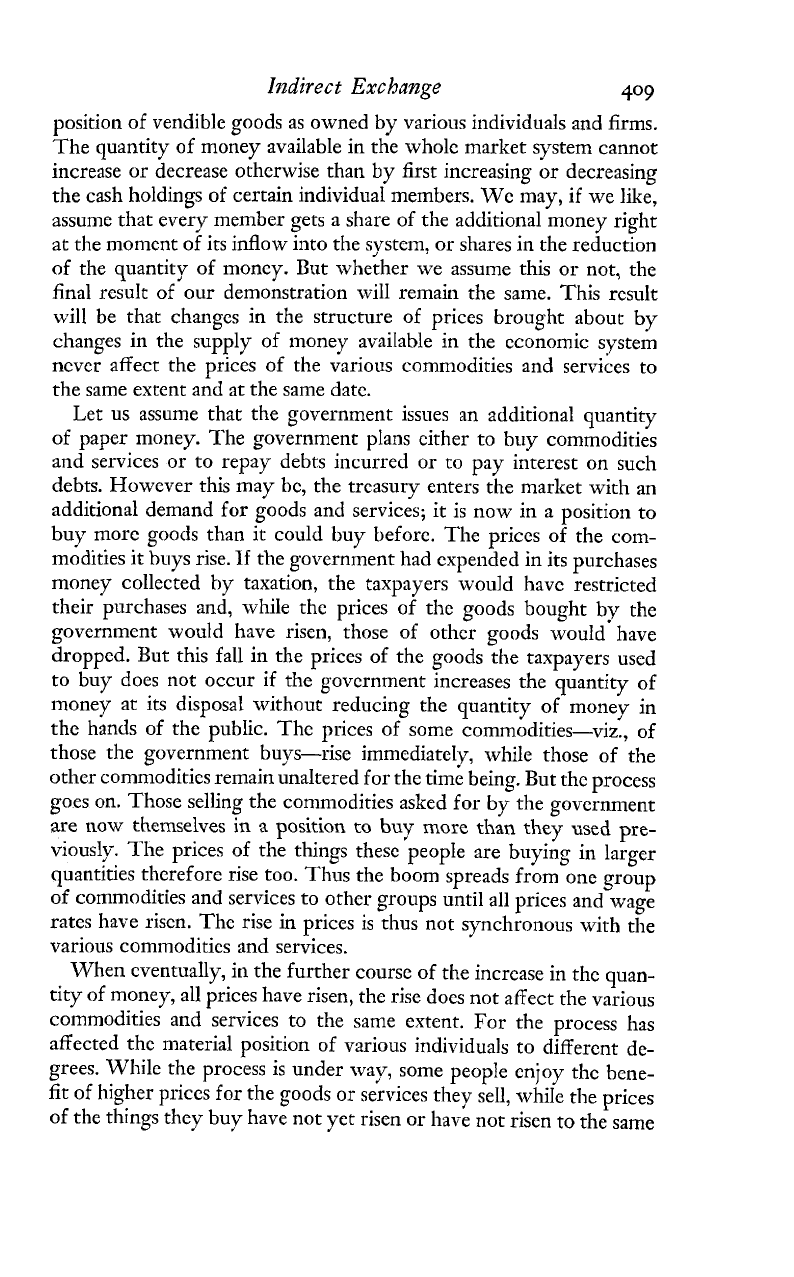
Indirect Exchange
409
position of vendible goods as owned by various individuals and firms.
The quantity of money available in the whole market system cannot:
increase or decrease otherwise than by first increasing or decreasing
the cash holdings of certain individual members.
Wc
may, if we like,
assume that every member gets a share of the additional money right
at the momcnt of its inflow into the system, or shares in the reduction
of the quantity of money. But whether we assume this or not, the
final result of our demonstration will remain the same. This rcsult
will be that changes in the structure of prices brought about by
changes in the supply of money available in the cconomic system
ncvcr affect the prices of the various commodities and services to
the same extent and at the same date.
Let us assume that the government issues an additional quantity
of paper money. The government plans either to b~iy commodities
and services or to repay debts incurred or to pay interest on such
debts. However this may be, the treasury enters the market with an
additional demand for goods and services; it is now in a position to
buy more goods than it could buy before. The prices of the corn-
modities it buys rise.
If
the government had expended in its purchases
money collected by taxation, the taxpayers would have restricted
their purchases and, while the prices of the goods bought by the
government would have risen, those of other goods would have
dropped. But this fall in the prices of the goods the taxpayers used
to buy does not occur if the government increases the quantity of
money at its disposal without reducing the quantity of money in
the hands of the public. The prices of some commodities-viz., of
those the govcrnment buys-rise immediately, while those of the
other commoditics remain unaltered for the time being-. But the process
goes on. Those selling the conmodities asked for by the government
are
now
themselves in
a
position
to
buy more than they used pre-
viously. The prices of the things these people are buying in larger
quantities therefore rise too. Thus the boom spreads from one group
of commodities and services to other groups until all prices and wage
rates have risen. The rise in prices is thus not synchronous with the
various commoditics and services.
When eventually, in the further course of the increase in the quan-
tity of money, all prices have risen, the rise does not affect the various
commodities and services to the same extent. For the process has
affected the material position of various individuals to different de-
grees. While the process is under way, some peopIe enjoy the hene-
fit of higher prices for the goods or services they sell, while the prices
of the things they buy have not yet risen or have not risen to the same
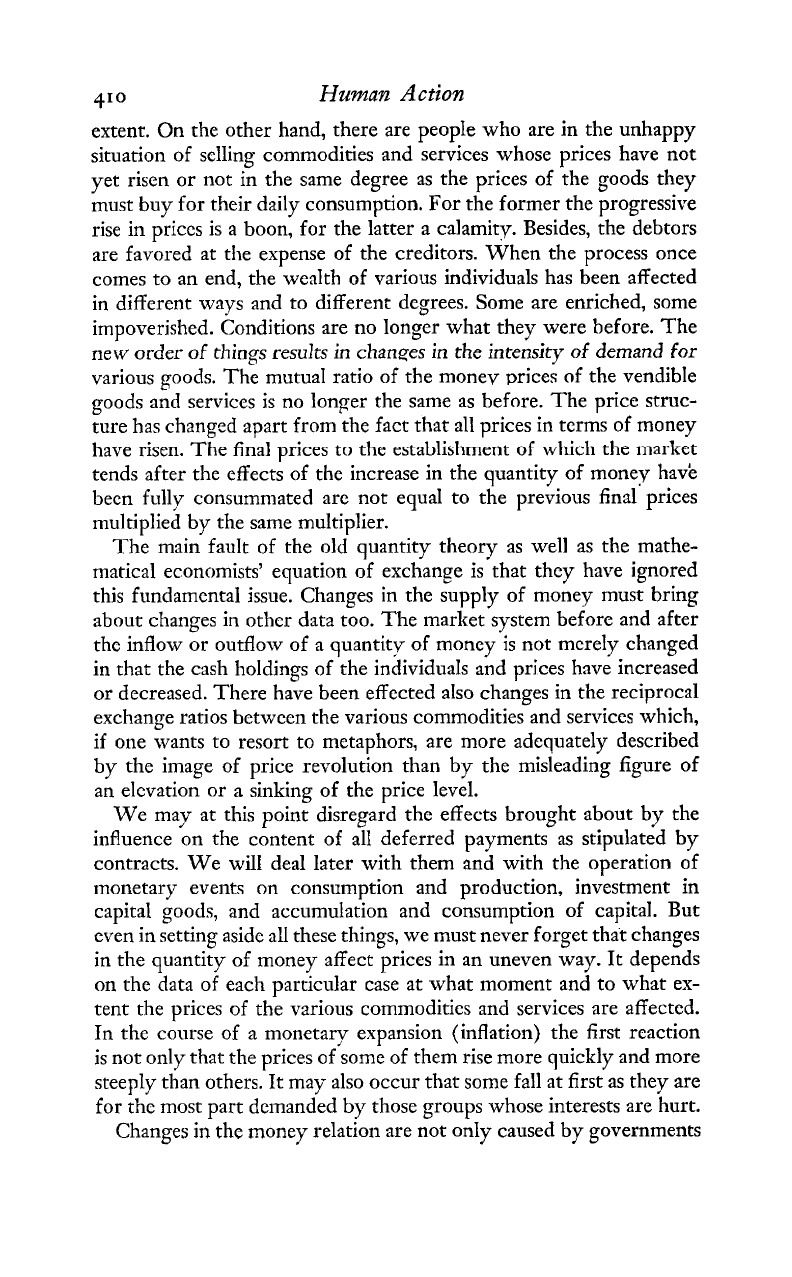
4'0
Human
Action
extent. On the other hand, there are peopIe who are in the unhappy
situation of selling commodities and services whose prices have not
yet risen or not in the same degree as the prices of the goods they
must buy for their daily consumption. For the former the progressive
rise in priccs is a boon, for the latter a calamity. Besides, the debtors
are favored at the expense of the creditors. When the process once
comes to an end, the wealth of various individuals has been affected
in different ways and to different degrees. Some are enriched, some
impoverished. Conditions are no longer what they were before. The
new order
of
things results in changes in the intensity of demand for
various goods. The mutual ratio of the monev prices of the vendible
goods and services is no longer the same as before. The price struc-
ture has changed apart from the fact that all prices in terms of money
have risen. The final prices to the establishment of which the market
tends after the effects of the increase in the quantity of monep havk
been fully consumn~ated are not equal to the previous final prices
multiplied by the same multiplier.
The main fault of the old quantity theory as well as the mathe-
matical economists' equation of exchange isvthat they have ignored
this
fundamental
issue. Changes in the supply of money must bring
about changes in other data too. The market system before and after
the inflow or outflow of a quantity of money is not merely changed
in that the cash holdings of the individuals and prices have increased
or decreased. There have been effected also changes in the reciprocal
exchange ratios bctwecn the various commodities and services which,
if one wants to resort to metaphors, are more adequately described
by the image of price revolution than by the misleading figure of
an elevation or a sinking of the price level.
We may at this point disregard the effects brought about by the
influence on the content of all defcrred payments
as
stipulated by
contracts. We will deal later with them and with the operation of
monetary events
on
consumption and production, investment in
capital goods, and accumulation and consumption of capital. But
even in setting asidc all these things, we must never forget that changes
in the quantity of money affect prices in an uneven way. It depends
on the data of each particular case at what moment and to what ex-
tent the prices of the various commodities and services are affected.
In the course of a monetary expansion (inflation) the first reaction
is not only that the prices of some of them rise more quickly and more
steeply than others. It may also occur that some fall at first as they are
for the most part demanded by those groups whose interests are hurt.
Changes in the money relation are not onIy caused by governments
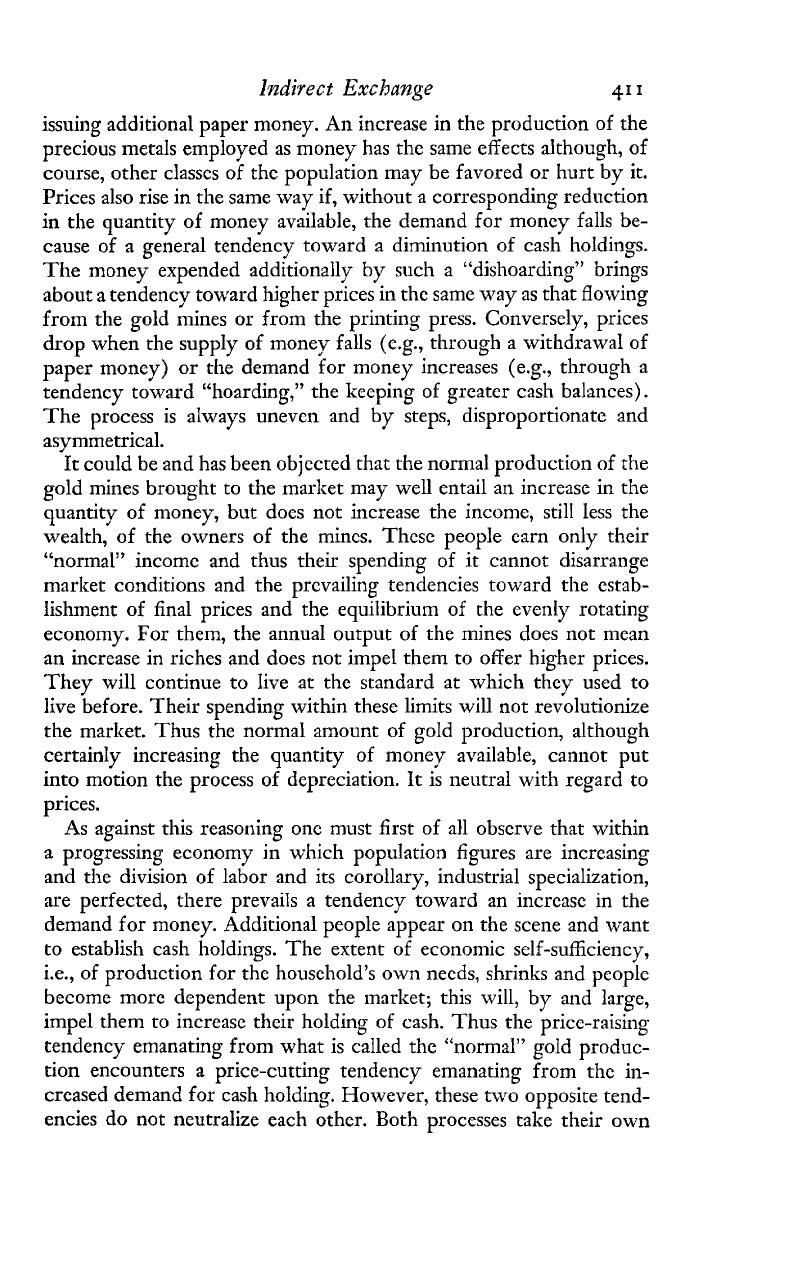
Indirect Exchange
411
issuing additional paper money.
An
increase in the production of the
precious metals employed as money has the same effects although, of
course, other classes of the population may be favored or hurt by it.
Prices also rise in the same way if, without a corresponding reduction
in the quantity of money available, the demand for money falls be-
cause of a general tendency toward a diminution of cash holdings.
The money expended additionally by such a "dishoarding" brings
about a tendency toward higher prices in the same way as that flowing
from the gold mines or from the printing press. Conversely, prices
drop when the supply of money falls (e.g., through a withdrawal of
paper money) or the demand for money increases (e.g., through a
tendency toward "hoarding," the keeping of greater cash balances).
The process is aIways uneven and by steps, disproportionate and
asymmetrical.
It could be and has been objected that the normal production of the
gold mines brought to the market may well entail an increase in the
quantity of money, but does not increase the income, still less the
wealth, of the owners of the mines. These people earn only their
"normal" income and thus their spending of it cannot disarrange
market conditions and the prevailing tendencies toward the estab-
lishment of final prices and the equilibrium of the evenly rotating
economy. For them, the annual output of the mines does not mean
an increase in riches and does not impel them to offer higher prices.
They will continue to live at the standard at which they used to
live before. Their spending within these limits will not revolutionize
the market. Thus the normal amount of gold production, although
certainly increasing the quantity of money available, cannot put
into motion the process of depreciation. It is neutral with regard to
prices.
As against this reasoning one must first of all obscrve that within
a
progressing economy in which population figures are increasing
and the division of labor and its corollary, industrial specialization,
are perfected, there prevaiis a tendency toward an increase in the
demand for money. Additional people appear on the scene and want
to establish cash holdings. The extent of economic self-sufficiency,
i.e., of production for the household's own needs, shrinks and peoplc
become more dependent upon the market; this will, by and large,
impel them to increase their holding of cash. Thus the price-raising
tendency emanating from what is called the "normal" gold produc-
tion encounters a price-cutting tendency emanating from the in-
creased demand for cash holding. However, these two opposite tend-
encies do not neutralize each other. Both processes take their own
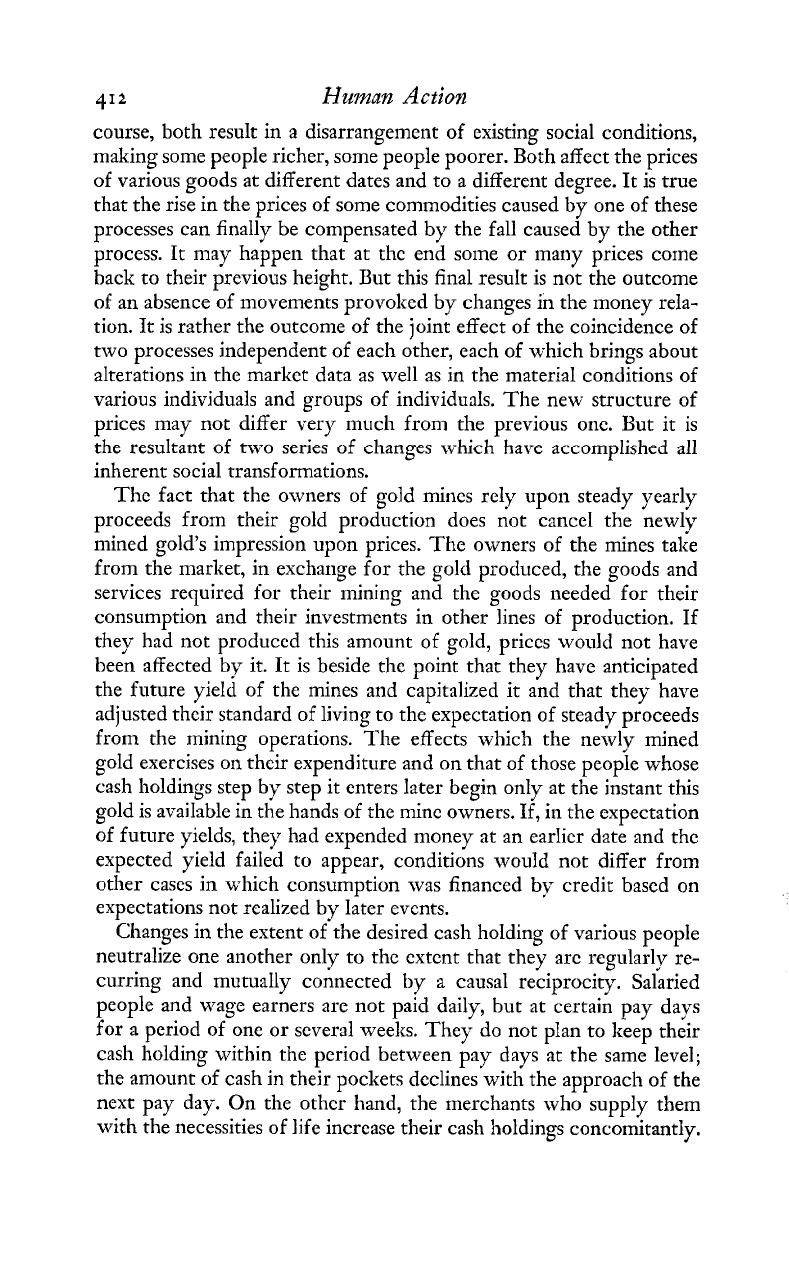
412
Human
Action
course, both result in a disarrangement of existing social conditions,
making some people richer, some people poorer. Both affect the prices
of various goods at different dates and to a different degree. It is true
that the rise in the prices of some commodities caused by one of these
processes can finally be compensated by the fall caused by the other
process. It may happen that at the end some or many prices come
back to their previous height. But this final result is not the outcome
of an absence of movements provoked by changes in the money rela-
tion. It is rather the outcome of the joint effect of the coincidence of
two processes independent of each other, each of which brings about
alterations in the market data as well as in the material conditions of
various individuals and groups of individuals. The new- structure of
prices may not differ very much from the previous one. But it is
the
resultant of two series of changes which have accomplished
all
inherent social transformations.
The fact that the owners of gold mines rely upon steady yearly
proceeds from their gold production does dot cancel the newly
mined gold's impression upon prices. The owners of the mines talie
from the market, in exchange for the gold produced, the goods and
services required for their mining and the goods needed for their
consumption and their investments in other lines of production. If
they had not produced this amount of gold, prices would not have
been affected by it. It is beside the point that they have anticipated
the future yield of the mines and capitalized it and that they have
adjusted their standard of living to the expectation of steady proceeds
from the mining operations. The effects which the newly mined
gold exercises on their expenditure and on that of those people whose
cash holdings step by step it enters later begin only at the instant this
gold is available
in
the hands of the mine owners. If, in the expectation
of funire yields, they had expended money at an earlicr date and the
expected yield failed to appear, conditions would not differ from
other cases in which consumption was financed
by
credit based on
expectations not realized by later events.
Changes in the extent ofthe desired cash holding of various people
neutralize one another only to the extcnt that they are regularly re-
curring and mutually connected by
a
causal reciprocity. Salaried
people and wage earners are not paid daily, but at certain pay days
for a period of one or several weeks. They do not pIan to keep their
cash holding within the period between pay days at the same level;
the amount of cash in their pockets declines with the approach of the
next pay day. On the other hand, the merchants who supply them
with the necessities of life increase their cash holdings concomitantly.
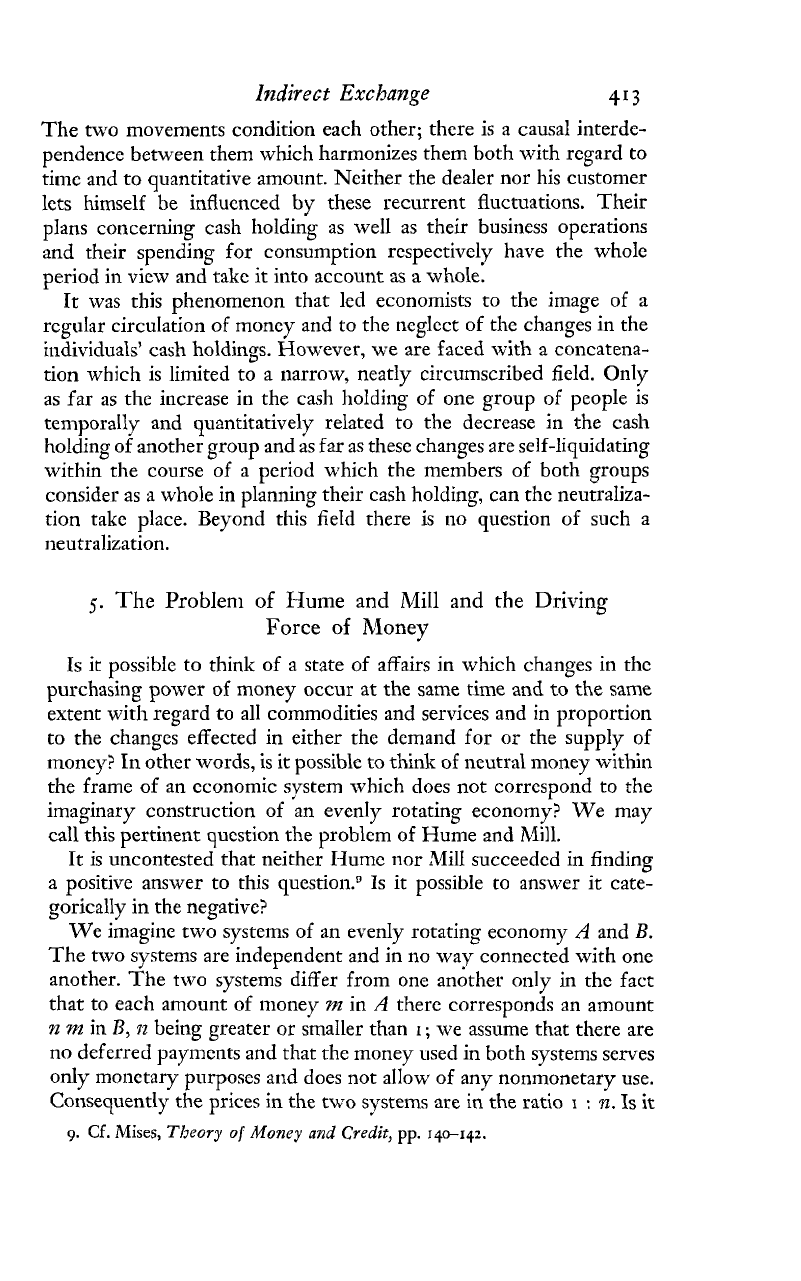
Indirect
Exchange
413
The two movements condition each other; there is a causal interde-
pendence between them which harmonizes them both with rcgard to
time and to quantitative amount. Neither the dealer nor his customer
lets himself be influenced
by
these recurrent fluctuations. Their
plans concerning cash holding as well as their business operations
and their spending for consumption respectively have the whole
period in view and take it into account
as
a whole.
It was this phenomenon that led economists to the image of a
regular circulation of money and to the tleglect of the changes in the
individuals' cash holdings. However, we are faced with a concatena-
tion which is limited to a narrow, neatly circumscribed field. Only
as far as the increase in the cash holding of one group of people is
ten~porally and quantitatively related to the decrease in the cash
holding of another group and as far as these changes are self-liquidating
within the course of a period which the members of both groups
consider as a whole in planning their cash holding, can thc neutraliza-
tion take place. Beyond this fieId there is no question of such a
neutralization.
5.
The
Problem of Hume and
Mi11
and the Driving
Force of Money
Is it possibie to think of a state of affairs in which changes in the
purchasing power of money occur at the same time and
to
the same
extent with regard to all commodities and services and in proportion
to the changes effected in either the demand for or the supply of
money? In other words, is it possible to think
of
neutral money within
the frame of an economic system which does not correspond to the
imaginary construction of an evenly rotating economy? We may
call this pertinent question the problem of Hume and
Mill.
It is uncontested that neither Ilume nor Mill succeeded in finding
-
a positive answer to this
question."^
it possible to answer
it
cate-
gorically in the negative?
We imagine two systems of an evenly rotating economy
A
and
B.
The two systems are independent and in no way connected with one
another. The two systems differ from one another only in the fact
that to each amount of money
nz
in
A
there corresponds an amount
n
m
in
B,
n
being greater or smaller than
I;
we assume that there are
no deferred paynlents and that the money used in both systems serves
only monetary purposes and does not allow of any nonmonetary use.
Consequently the prices in the two systems are
in
the ratio
I
:
n.
Is
it
9.
Cf.
Mises,
Theory
of
Money
and
Credit,
pp.
140-142.
